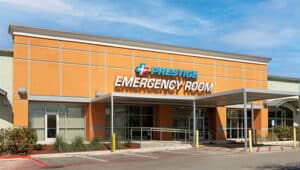Freestanding emergency rooms are vital during this pandemic. They are caring for coronavirus patients, thereby lightening the load on local area medical facilities. This happened due to a request from the Association of Freestanding Emergency Centers in Texas. They asked the Health and Human Services Commission to change the rules, letting freestanding clinics help reduce hospital overcrowding.
The change also allows them to provide necessary services such as radiology and imaging.
These changes let emergency rooms help by:
- Carrying out more tests
- Reducing the spread of the virus
- Assisting with the influx of inpatients at local hospitals
- Taking advantage of hospital resources
What are freestanding ER’s?
Freestanding ERs can provide emergency medical services in an area that is not served by a regular hospital.
These facilities can treat any conditions or injuries an ER in a hospital would. They are mainly used to cater to the demand for emergency medical services in rural areas or where hospitals are located farther away.
How are they different from hospital ERs?
Both hospital ERs and freestanding ERs are open 24 hours a day, 7 days a week. They both have staff members that include emergency nurses, doctors, and lab technicians.
Additionally, both facilities are fully equipped to handle life-threatening injuries such as fractures, stroke, heart attacks, and also respiratory problems.
The key difference happens during admission to a hospital. Hospital ERs usually have access to inpatient admissions, while Freestanding ERs require ambulances to transport their patients to the hospitals.
Freestanding ERs can also tend to have shorter wait periods and a higher patient satisfaction rank in comparison to hospital ERs. So, instead of sitting in a waiting room with screaming babies and constant ambulance sirens ringing in your ears, visit a freestanding ER.
Are the costs higher in Freestanding ERs?
The cost of emergency care in a freestanding ER is almost the same as the costs at a hospital. However, freestanding ERs were previously not allowed to accept Medicare and Medicaid patients. This recently changed, however, as federal officials formally announced that Freestanding ERs in Colorado, Texas, Rhode Island, and Delaware can temporarily treat Medicaid and Medicare holders. This change is expected to help relieve some of the pressure on hospitals that are inundated with coronavirus patients.
Now, the healthcare sector can see more patients. This temporary approval has freed nearly 1,500 beds in Freestanding emergency rooms throughout Texas for Coronavirus response teams. The change gives area hospitals more space to accommodate the overflow of those needing emergency care that is not related to Coronavirus.
That is not all, though. The CMS has also issued various regulatory waivers and new rules. This allows healthcare providers to be more flexible, enabling a better response to the COVID-19 pandemic. The most notable change is the ability to bill federal health insurance programs during the pandemic. This policy lasts until the public health emergency is under control.
Before these laws were passed, many people preferred hospital ERs, given their many insurance options. Currently, though, with new state laws requiring that freestanding ERs disclose the network health plans that they have agreements with, the charges are virtually the same as in a hospital ER.
These changes make freestanding ERs more accessible to the general public, including those who rely on federal health insurance. Plus, since these facilities are highly regulated with staff on hand on a 24/7 basis, they are a reliable source of care for anyone that needs them.
Where do you go for treatment between the two?
As the situation of the coronavirus crisis is still not ceasing, hospitals are considered infection grounds, and patients are urged to get tested at freestanding clinics. Plus, with the new governmental coronavirus relief legislation, these tests are offered at no cost. You don’t have to pay any additional fees to get you, or any family member tested.
If you feel that you or a family member may have COVID 19 disease, but you would prefer not to go to the hospital emergency room for fear of getting infected, visit a freestanding clinic to get tested.
Freestanding ERs have quickly adapted to meet the needs of patients during this pandemic. Make use of the additional options available should you need emergency care!












